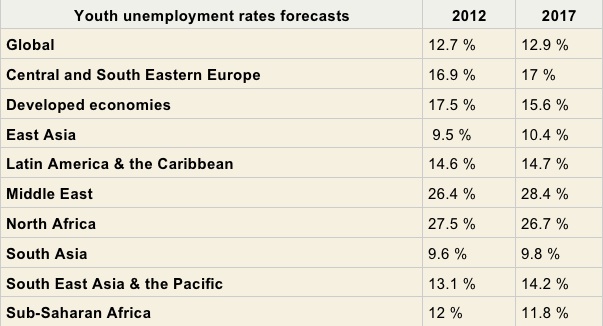
This is a bad time to be young and looking for work.
Globally, the youth unemployment rate is expected to stagnate at 12.7 percent this year and rise above that in coming years.
No region will escape the deterioration of employment conditions for young people.
Even dynamic Asian economies that, until recently, appeared immune to the European contagion are starting to feel the pain. In East Asia, the youth unemployment rate is set to increase from a current 9.2 percent to over 10 percent by 2017 -- a historic high in a region that was used to full employment.
Only in developed economies is the youth unemployment rate expected to fall, but the harsh reality behind those figures is that increasingly desperate young people have simply given up looking for a job. Between 5 and 6 million youth have dropped out of the labor market since the beginning of the crisis, and the number is expected to increase further as the job market is not likely to improve any time soon.
So what can countries do to improve the outlook for young people?
The recipe sounds obvious: create jobs and young people will find employment. Unfortunately, it's far from being that simple.
For starters, the sheer size of the problem means that even a quick acceleration in growth may not provide sufficient job opportunities. In Spain alone, almost 1 million young people are currently searching for a job. In the United Kingdom, the number is equally high, and in developed economies, more than 10 million jobs are missing for youngsters.
Recovery appears far off
Advanced economies face the risk of another recession over the next 12 months, and the unsettled climate is depressing the outlook in emerging economies in Asia and Latin America. World trade has decelerated, commodity prices have declined and companies are holding back any new investment projects that could create new jobs. This all bodes ill for a quick jobs recovery.
There is one thing that countries can and should do: Provide training and job guarantees to limit the long-term consequences of the crisis.
Several countries have experimented with such schemes, including during the early stages of the crisis. In Austria, young people who have been looking for a job or a training possibility for longer than six months can rely on direct support from local authorities to access a subsidised training place. Such programmes, if properly targeted, can help ensure that young people do not drop out completely from the labour market. And, if correctly designed, they can be affordable.
ILO estimates show that even in crisis countries, such measures would cost no more than 0.5% of GDP, a small amount when compared with the funds that have been released to bail out the banking sector in these countries. But countries need to act fast to ensure the youth employment crisis does not become endemic. Otherwise, there truly is a risk that the youth will become a "lost generation."
